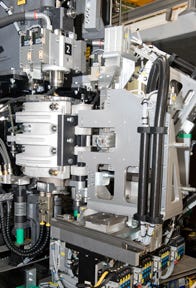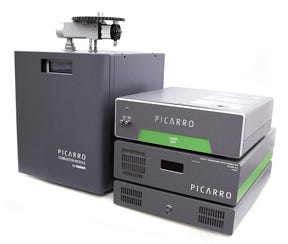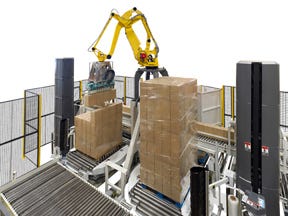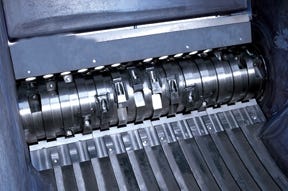The development of materials and machinery for packaging applications continues at a rapid pace, which is why both IMM and MPW cover them in every issue of the respective magazines. For this special Focus on Packaging issue, we’ve collected some recent innovations from around the world. Hardly a complete list, it offers insight into some of the latest steps being taken by some of the leading suppliers. Time to fill your shopping cart?Film extrusion
May 17, 2010
The development of materials and machinery for packaging applications continues at a rapid pace, which is why both IMM and MPW cover them in every issue of the respective magazines. For this special Focus on Packaging issue, we’ve collected some recent innovations from around the world. Hardly a complete list, it offers insight into some of the latest steps being taken by some of the leading suppliers. Time to fill your shopping cart?
Film extrusion
ULDPE blends enable downgauging of frozen food films
Improved blown-film structures that blend ultralow-density polyethylene (ULDPE) with either linear low-density polyethylene (LLDPE), copolymers (EVA), or low-density polyethylene (LDPE) can help to improve the abuse resistance of flexible packaging films for frozen food applications. According to field tests recently conducted by Dow Europe GmbH, the supplier’s Attane brand of ULDPE can help brand owners and converters meet their sustainability improvement targets.
Flexible packaging films used in frozen food applications must resist puncture and tear from the contents of the package itself and also from potential physical or environmental abuse as the package moves through the frozen food supply chain. Dow has developed and tested two new blended film solutions using Attane resins that can be of interest to flexible packaging processors.
The first is an 80/20 LLDPE/LDPE monolayer film where a minor portion of 20% of Attane SL 4102G replaced parts of the LLDPE. In performance tests comparing this film with the incumbent monolayer LLDPE film, the minor addition exhibited an improvement in Elmendorf Tear, dart impact, and instrumented dart impact at low temperature, and a more than 45% improvement in puncture resistance, all without significantly impacting the raw material cost.
The second film used the enabling ULDPE as a 30% blend in the 50% core of a three-layer film structure. When comparing the properties of the film structure with ULDPE in the core with the monolayer LLDPE benchmark, the Elmendorf Tear, dart impact, and instrumented dart impact at low temperature all improved. The puncture resistance even improved by 195%, again without significantly impacting raw material cost.
The toughness properties in the three-layer film structure with a ULDPE blended core are so significantly enhanced that they allow the film to be further downgauged. Dow found that the gauge of such a film could be reduced by up to 20% and still deliver a more than 50% improvement in dart impact and an almost 140% improvement in puncture resistance compared to a benchmark monolayer film.
The degree to which this structure could be downgauged would, of course, depend on the overall criteria of the required film application. Nonetheless, Dow’s tests demonstrated that an Attane ULDPE blended core could help converters reduce their total costs as well as help them meet the sustainability improvement targets now being set by many brand owners and retailers.
Top-notch seal at rapid line speeds? Get one, and more, 
from these new materials
ExxonMobil Chemical (Houston, TX) has launched a four-grade suite of its Vistamaxx propylene-based elastomers for use in films, saying the materials have a positive impact on everything from package seal integrity to line speeds. Carol Fitzpatrick, global development manager for Vistamaxx in films, says the material is helping processors react to a changing market, noting that equipment manufacturers are increasingly offering higher-speed packaging equipment, with some systems capable of rates as high as 80 m/min.
“There are few films in the market today that can run at those speeds or anywhere near them,” Fitzpatrick says, adding that Vistamaxx’s ability to lower seal-initiation temperatures and broaden the hermetic sealing window have allowed converters to better match their output with the new machine capacities. Conversely, if a converter has spare capacity, Fitzpatrick says Vistamaxx can allow it to lower the temperature at which, for example, horizontal form-fill-and-seal machines run, and so reduce the line’s overall energy usage. The company has seen this benefit within the cast polypropylene (CPP) film market for products like confectionaries, among others, with seal-initiation temperatures typically 10-15ºC lower.
The Vistamaxx suite’s impact on films and how they interact with processing and converting equipment has actually prompted a five-company collaboration among ExxonMobil Chemical, a brand owner, a packaging equipment manufacturer, a CPP film extruder, and a laminator to work on high-speed film.
The amount of Vistamaxx added to the film depends on the application, with use as a cling agent requiring very low levels while an elastic film would be composed primarily of Vistamaxx. In general, for packaging films, less than 20% is used.
The primary differences among the four Vistamaxx grades—6202FL, 6102FL, 3980FL, and 3020FL—center on ethylene content and melt flow rate (MFR), according to Brent Johnson, Vistamaxx films market developer.
Vistamaxx 6202FL has an ethylene content of about 16%, an MFR of 20 using a 230°C test, and is designed for extrusion coating and lamination applications. Aggressive adhesion to the substrate with which it’s bonding is a common characteristic.
Vistamaxx 6102FL also has an ethylene content of around 16% but an MFR of 3. Designed for elastic-film applications, Johnson notes that it’s turning into “a real multipurpose product,” with additional application as an “elastic engine” in personal care elastic hygiene applications and as a cling additive in stretch films. Both 6102FL and 6202FL are also used as the adhesive layer of surface-protective films.
Vistamaxx 3980FL has ethylene content of 9% and an MFR of 8. Designed as a cast-film grade, Johnson says its predominant use would be for seal-layer modification. Vistamaxx 3020FL has ethylene content of 11% and the highest molecular weight of the group, resulting in the lowest MFR (2). It’s made to give blown film as much melt strength as possible. One potential application would be the core of a stretch hood.
Currently Vistamaxx is made only at the ExxonMobil site in Baton Rouge, LA, but a new site with nameplate capacity of 300,000 tons/year for the production of specialty elastomers, including Vistamaxx, is set to open in 2011 in Singapore, which will expand the material’s availability in response to strong market demand. “I can tell you that [Vistamaxx’s growth rate] is one of the most significant growth rates that we’ve ever seen in launching a new polymer,” Fitzpatrick says.
Blowmolding
Semiautomatic system clips 75% off of mold changeover times
|
Packaging machinery manufacturer Krones AG (Neutraubling, Germany) has developed a new system called MouldXpress Advanced to help operators of the company’s Contiform stretch blowmolding machinery reduce mold changeover times by up to 75%.
Krones says the system is integrated into a machine’s blowing wheel and shortens the changeover time from about 3.5 minutes to less than 1 minute per blowmolding station. Rotary blowmolding machines from Krones are offered with eight to 40 blowing stations, but so far the MouldXpress Advanced is only offered for the machines of the S16 to S28 series (16-28 mold cavities) and for relax-type molds with neck cooling. Still, the time savings on a complete changeover on the 28-cavity machines can be up to 72 minutes, enough time to blowmold about 50,000 bottles on that machine.
On the new system, the different mold sets are stored on a changing trolley, with the trolley’s compartments labeled to avoid incorrect identification of the molds. No extra tools are required.
Injection molding
‘Major leap’ into packaging market
Injection molding machine manufacturer Arburg placed packaging front and center at its March Technology Days open house, an annual event that this year drew about 4000 processors to the company’s Lossburg, Germany headquarters. Arburg, best known for its Allrounder injection machines for consumer goods, E/E, and automotive applications, expects recent additions to its portfolio should make it a force in the packaging sector.
“With our Hidrive [hybrid drive] system, we’ve machines now able to run faster, which definitely should help us increase our presence in packaging,” said Herbert Kraibühler, managing director, technology, of the company’s renewed focus on packaging. He added, “These Technology Days are really our major leap into the packaging market.”
The company’s packaging forum within the open house included a molding cell based on an Allrounder 720 H (320 tonnes clamp force) running a 72-cavity closure mold (1.6g closures for still water) at 3-second cycles (mold from Austria’s KTW). Other exhibits included molding cells for thin-walled packaging, inmold-labeled containers, and more.
PET preform machine designed from ground up
Previously, Korean machine builder Dongshin Hydraulics Co. (Busan) offered an injection press that was essentially modified for molding PET preforms, but its latest offering is designed specifically for the task. The Pro PET 380 uses two accumulators and a servodrive pump, and a servomotor drives plasticating via a gearbox to help accelerate cycle time to 17 seconds for a 24-cavity tool molding 24g preforms. “Sure, we’re slower than state-of-the-art machinery, but our 380-tonne double-toggle machine only costs $180,000,” says Phillip Kim, executive VP at Dongshin. “The drive system we adopt also saves 50% on energy compared with hydraulic machines, and operation is at a quiet 74 dB.”
Testing equipment
Does that part really contain bioplastics? The proof’s 
in the isotopes
Bioplastics continue to get a lot of press, and are one of the fastest-growing segments of the plastics and packaging industries. More and more consumer packaged goods companies have announced campaigns to integrate bioplastics into their packaging to reduce their carbon footprint, and thus attract eco-conscious buyers. But how can processors be certain that the amount of bioplastic content that is promoted in a material actually exists in the resin?
Picarro Inc., a Sunnyvale, CA technology company, says it can help make that determination with its Combustion Module-Cavity Ring-Down Spectrometer (CM-CRDS) for stable carbon isotopic analysis. According to Picarro’s CEO Mike Woelk, the CM-CRDS makes analysis push-button simple for companies to verify the bioplastics composition of polymers or finished materials throughout the supply chain, whether on the factory floor or at the distributor’s warehouse.
There are two massive cycles that are going on, explained Woelk in a telephone interview. Those are the carbon cycle and water cycle, and both CO2 and H2O are very dynamic molecules. “You can determine how CO2 moves in the universe and where it originated—shale gas, coal, natural gas, all have a distinctive isotopic pattern. We measure it as a family of molecules based on the carbon that is in it,” Woelk said.
Previously, this type of measurement required expensive and disruptive testing in specialized labs, but Picarro’s solution gives both plastics consumers and suppliers a tool to ensure that bioplastics content claims can be verified in minutes without disrupting ongoing production.
To determine whether a material is bioplastic or “petroplastic,” it is burned, and the composition of the CO2 is measured to determined where it originated. “There are very distinct signatures for CO2—soy, corn, rice, etc.,” said Woelk. “We make it easy—shop ready—so that you can put a piece of plastic into the device and immediately determine the material’s integrity throughout the supply chain.”
Woelk agreed that there’s a lot of hype surrounding bioplastic products, and added that the manufacturers of beverages, food products, and medical devices, “regardless of their philosophical point of view,” want to support their consumers’ buying preferences with respect to being eco-friendly. “How do you know the truth? That’s what we provide and it’s as simple as you can get,” Woelk stated. “What we’re talking about is analytical-grade results as good as any technology in the world can produce, and you don’t need to be a scientist to do the work.”
The CM-CRDS is a tabletop unit that performs a bulk specific isotope analysis and delivers isotopic carbon measurements of plastics and other packaging materials in roughly 10 minutes. It’s designed to run up to 147 plastic samples consecutively without operator intervention, and with minimal training and setup time. Woelk noted that Picarro is in the very early stages of commercialization of its technology, even though it has been around for several years. “We’ve just gained commercial traction in the past two years,” he said.
Picarro sees rapidly emerging trends as a result of the green movement, and along with these trends, the regulatory environment will evolve. “More regulations will evolve by hook or by crook,” Woelk commented. “I think people think that these bioplastics markets are all big established markets, but they’re not. It’s a lot like the dotcom movement in the early days. There are very few companies that are making any money in the green space currently. And there are issues surrounding bioplastics, such as commingling bioplastics and petroplastics, which contaminates the resin stream. It will be important that manufacturers can produce scientific results to match the suppliers’ claims.”
Auxiliary Equipment
Bulky, airy bottles palletized and wrapped
A new system that integrates palletizing and wrapping operations into one simplified, integrated cell offers greater efficiency for stretch-wrapping pallets.
Schneider Packaging Equipment Co. Inc. (Brewerton, NY), a manufacturer of case packers, tray packers, tissue wrapping, and bundling and robotic palletizing systems, along with Lantech, a Louisville, KY-based packaging company, teamed up to offer the new Stack and Wrap Palletizing/Stretch Wrapping Cell. This Cell combines two or more lines into a centralized automated palletizing stretch-wrapping station, and offers more efficient handling by building the unit load on the stretch wrapper, and stabilizing lightweight, unstable loads in a reduced floor space.
The palletizing system, engineered by Schneider, centers around a Fanuc robotic arm between two Lantech Q-600 stretch wrappers. Xpedx, a Lantech distributor, identified how the machines should interface and initiated the collaboration between the parties, says Schneider.
Terry Zarnowski, director of sales and marketing for Schneider Packaging, says the Stack and Wrap Palletizing system was designed to handle “highly unstable pallet loads with such products as blowmolded bottles, which are bulky but in which the converter is shipping nothing but air.” Explains Zarnowski, “We came up with a solution that provides them with the ability to build up full-height unit loads, and we can build and wrap the load together—build two layers, wrap it, build another two layers, wrap it, etc., and do that with minimal cost.”
An automatic pallet dispenser and conveyor system delivers an empty pallet to each stretch wrapper, while product is delivered from two production lines to the palletizing cell. The robotic arm builds layers of product on each of the wrappers. Once a predetermined number of cases are loaded onto the first pallet, the first wrapper stabilizes the load layers by applying stretch film.
At this point, the robotic arm begins building a load on the second stretch wrapper. This process repeats as the wrapper and robotic arm alternate building and wrapping the load in predetermined increments until the load is complete and product is discharged to a conveyor transfer system. The system is designed to handle two different products simultaneously, thus allowing the system to maintain high throughput during wrapping.
The Lantech Q-600 includes special logic and hardware made for this design, as well as Lantech’s patented Pallet Grip load-containment system to lock the load to the pallet for safe transport. For this application, the film is stretched at 250%, translating into 10 ft of raw film becoming 35 ft when applied to the load.
Schneider customized a wide range of EOAT (end-of-arm tooling) to facilitate complete consolidation of case, tray, or bag lines onto one central palletizing system. Pallet loading and exchange operate automatically for continuous production. “If there is a high volume of parts coming out of a molding machine, the cell can handle two lines at the same time for faster packing,” says Zarnowski. “Or it can handle a very high-speed line that needs the two lines.”
Shredder upgrade saves energy, improves throughput
More throughput while using less energy is a pretty good trade-off, and that exchange is said to be realized as the result of recent upgrades to the established Vega-brand shredders from manufacturer Lindner reSource GmbH (Grossbottwar, Germany). Even at a modest speed of up to 250 revolutions/min, the company’s newly developed Super-Vega model can reduce plastic scrap to pellets sized 10-15 mm.
As a result, claims the manufacturer, processors can forego using conventional cutting mills, get pellets sized as they want, and still realize the benefits of a single-shaft shredder, such as large feeding hoppers, startup under load, and low costs for wear and tear. The upgraded machines are said to be especially well suited for the shredding of difficult materials such as big bags, filaments, and films.
The company says the Vega S (Super) 1100 single-shaft shredder can achieve a throughput capacity of 500-800 kg/hr with a drive power of only 22 kW, an output/energy-use ratio it says is realized largely as a result of the development of its square-blade rotor.
About the Author(s)
You May Also Like








